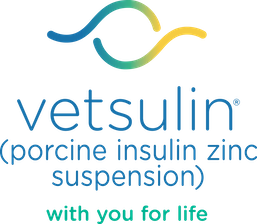
Dosing Overview
Learn More About Dosing & Administration
FDA Approved for Cats
Administration information is useful to share with clients and hospital staff to ensure the proper amount of insulin is given.
Vetsulin® (porcine insulin zinc suspension)
Vetsulin® 10 mL vials and 2.7 mL cartridges should be shaken thoroughly until a homogeneous, uniformly milky suspension is obtained.
Syringe Administration Instructions For Cats
VetPen®
Taking the proper steps to prepare VetPen® is critically important and must be done before each injection.
VetPen® Administration Instructions For Cats
Dosing Schedules
For cats, the initial recommended dose of Vetsulin® is 1 to 2 IU per injection. Cats should be started on twice-daily injections of Vetsulin at 12-hour intervals. In cats, Vetsulin dosing is calculated on a per animal basis (initial dosing for dogs is based on body weight).
In cats, initially administer twice-daily doses 12 hours apart, concurrently with or right after meals fed twice daily. (No change in feeding schedule is required for cats fed ad libitum.) Reevaluate the cat at appropriate intervals and adjust the dose based on clinical signs, urinalysis results, and glucose curve/spot check values until adequate glycemic control has been attained.
Achieving Effective Glycemic Control
The goals of managing feline diabetes mellitus include:
- Controlling the clinical signs of hyperglycemia (polyuria, polydipsia)
- Avoiding hypoglycemia*
- Obtaining blood glucose curve values in the desired range:*
- Cats: 120–300 mg/dL over the course of the day, with a nadir between 100–125 mg/dL
*In the US clinical study, glycemic control was considered adequate if an acceptable blood glucose curve was achieved (ie, reduction in hyperglycemia and a nadir of 60–160 mg/dL), however, the Technical Services department believes that a nadir below 100 mg/dL in cats may warrant a decrease in the dose.
Further adjustments in dosage may be necessary with changes in the cat’s diet, body weight, medications, or if the cat develops concurrent infection, inflammation, or other medical disorders.
For long-term management dosage information, click here.
Help Your Practice Manage
Diabetes Mellitus
Check out these tools and resources to help manage feline diabetes.

Blood Glucose Curve Generator
Create a blood glucose curve to monitor and evaluate diabetes treatments.

Client Discharge Form
Create a customized, printable form for clients about their new diagnosis.

Diabetes Resources
Access online tools and more to support staff and pet parents.
No items to show.
Learn More About Dosing & Administration
Important Safety Information:
Vetsulin® should not be used in dogs known to have a systemic allergy to pork or pork products. Vetsulin is contraindicated during periods of hypoglycemia. Keep out of reach of children. As with all insulin products, careful patient monitoring for hypoglycemia and hyperglycemia is essential to attain and maintain adequate glycemic control and prevent associated complications. Overdosage can result in profound hypoglycemia and death. The safety and effectiveness of Vetsulin in puppies, breeding, pregnant, and lactating dogs has not been evaluated. See package insert for full information regarding contraindications, warnings, and precautions.
References:
1. Martin GJ, Rand JS. Pharmacology of a 40 IU/ml porcine lente insulin preparation in diabetic cats: findings during the first week and after 5 or 9 weeks of therapy. J Feline Med Surg. 2001;3(1):23–30. 2. Vetsulin® (porcine insulin zinc suspension) [Freedom of Information Summary]. Millsboro, DE: Intervet Inc.; 2008. 3. Data on file, Merck Animal Health. 4. Graham PA, Nash AS, McKellar QA. Pharmacokinetics of porcine insulin zinc suspension in diabetic dogs. J Small Anim Pract. 1997;38(10):434–438. 5. Martin GJ, Rand JS. Pharmacokinetic and Pharmacodynamic Study of Caninsulin in Cats with Diabetes Mellitus. 2000: Internal Study Report. 6. Feldman EC, Nelson RW. Canine and Feline Endocrinology and Reproduction. 3rd ed. St. Louis, MO: Saunders; 2004:539–579. 7. Tennant B, ed. BSAVA Small Animal Formulary. 4th ed. Gloucestershire, UK: British Small Animal Veterinary Association; 2002. 8. Feldman EC, Nelson RW. Canine and Feline Endocrinology and Reproduction. 3rd ed. St. Louis, MO: Saunders; 2004:486–538. 9. Reusch C. Feline diabetes mellitus. In: Ettinger SJ, Feldman EC, eds. Textbook of Veterinary Internal Medicine. 7th ed. St. Louis, MO: Saunders; 2010:1796–1816. 10. Nelson RW. Canine diabetes mellitus. In: Ettinger SJ, Feldman EC, eds. Textbook of Veterinary Internal Medicine. 7th ed. St. Louis, MO: Saunders; 2010:1782–1796. 11. Burgaud S, Riant S, Piau N. Comparative laboratory evaluation of dose delivery using a veterinary insulin pen. In: Proceedings of the WSAVA/FECAVA/BSAVA congress; 12–15 April 2012; Birmingham, UK. Abstract 121. 12. Burgaud S, Guillot R, Harnois-Milon G. Clinical evaluation of a veterinary insulin pen in diabetic dogs. In: Proceedings of the WSAVA/ FECAVA/BSAVA congress; 12–15 April 2012; Birmingham, UK. Abstract 122. 13. Burgaud S, Guillot R, Harnois-Milon G. Clinical evaluation of a veterinary insulin pen in diabetic cats. In: Proceedings of the WSAVA/FECAVA/BSAVA congress; 12–15 April 2012; Birmingham, UK. Abstract 45. 14. Davison, et al. J Vet Intern Med 2008; 22:1317-1325. 15. Banfield State of Pet Health 2016 Report. p 12-13
